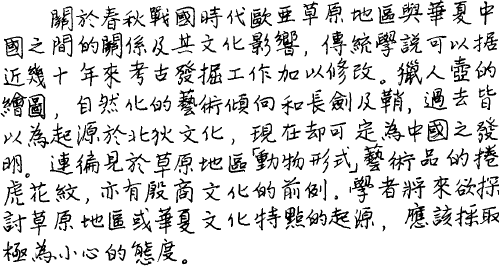Published online by Cambridge University Press: 26 March 2015
The old accepted theories concerning the direction of cultural influence between China and the Eurasian steppes during the Eastern Zhou period need to be reassessed in the light of recent archaeological discoveries. The pictorial scenes on the “Hunting Hu,” the trend toward naturalism, the long sword and scabbard slide, all credited at one time or another to northern barbarian influence, can now be shown to reflect Chinese innovations instead. A Shang priority can be recognized for the coiled feline, which was to become a leitmotif of the steppe “Animal Style” world. In the future, extreme caution is suggested when attempting to identify the ultimate cultural source for any unusual steppe or Chinese feature that seems exotic.


1. Rostovtzeff, M., Iranians and Greeks in South Russia (Oxford, 1922)Google Scholar, and The Animal Style in South Russia and China (Princeton, 1929)Google Scholar.
2. Fong, Wen, ed., The Great Bronze Age of China (New York, 1980), p. 309 Google Scholar.
3. Delbanco, Dawn Ho, Art From Ritual: Ancient Chinese Bronze Vessels from the Arthur M. Sackler Collections (Washington and Cambridge, 1983), pp. 20–21 Google Scholar.
4. Fong, , ed., The Great Bronze Age, pp. 252 and 262 Google Scholar.
5. Trousdale, William, The Long Sword and Scabbard Slide in Asia (Washington D.C., 1975), p. 118 Google Scholar.
6. Major, John S., “Research Priorities in the Study of Chu Religion,” History of Religions vol. 17.3–4 (02-May 1978):235 CrossRefGoogle Scholar.
7. Fong, , ed., The Great Bronze Age, p. 310 Google Scholar.
8. Fong, , ed., The Great Bronze Age, pp. 310 and 319 Google Scholar.
9. Major, op. cit., p. 231.
10. Weber, Charles, “Chinese Pictorial Bronze Vessels of the Late Zhou Period,” Artibus Asiae 30.2–3 (1968):201 CrossRefGoogle Scholar.
11. Lawton, Thomas, Chinese Art of the Warring States Period (Washington, D.C., 1982), pp. 10–11 Google Scholar.
12. See note 7.
13. Weber, , Artibus Asiae 28.2–3 (1966):131 Google Scholar.
14. Weber, , Artibus Asiae 30.2–3 (1968):212 CrossRefGoogle Scholar.
15. Ibid., figs. 62-65 and 70-71.
16. Meyers, Pieter, “Applications of X-Ray Radiography in the Study of Archaeological Objects,” Advances in Chemistry Series, no. 171, Archaeological Chemistry II (1978):90 Google Scholar.
17. Frozen Tombs, published for the Trustees of the British Museum (1978), figs. 22, 37, 38, 40, 43-51Google Scholar, and Rudenko, S. I., The Frozen Tombs of Siberia (London, 1970)Google Scholar, figs. 108-117, and pp. 229-278.
18. For a more extensive discussion of this theory see Bunker, Emma C., “Sources of Foreign Elements in the Culture of Eastern Zhou Culture,” in Kuwayama, George, ed., The Great Bronze Age of China (Los Angeles, 1983), p. 89, fig. 5Google Scholar.
19. Rudenko, p. 270.
20. Weber, , Artibus Asiae 30.2-3 (1968)CrossRefGoogle Scholar: figs. 79, 62, and 63.
21. Rudenko, pl. 178 and fig. 55.
22. Weber, , Artibus Asiae 30.2-3 Google Scholar:pl.32.
23. Chang, Kwang-chih, Shang Civilization (New Haven and London, 1980)Google Scholar, pl. 19.
24. For a recent discussion of Eastern Steppe material see Bunker, Emma C., “Ancient Art of Central Asia, Mongolia, and Siberia,” in Moorey, P. R. S. et al., Ancient Bronzes, Ceramics, and Seals, cat., (Los Angeles, 1981), pp. 140–176 Google Scholar.
25. Karlgren, B., “Ordos and Huai,” BMFEA 9 (1939):97–112 Google Scholar, and Weber, , Artibus Asiae 30.2–3 (1968): 202–213 CrossRefGoogle Scholar.
26. Major, pp. 231 and 235-237.
27. Early China 7 (1981–1982):83 Google Scholar.
28. See Bunker, “Foreign Elements,” for a detailed discussion.
29. Hao, Qian, Heyi, Chen, and Suichu, Ru, Out of China's Earth (New York and Beijing, 1981), p. 33 Google Scholar.
30. Scientific American 1980.2:191 Google Scholar and Wenwu 1980.7:6 Google Scholar.
31. See Jettmar, Karl, Art of the Steppes (New York, 1967), p. 195 Google Scholar and Bunker, “Foreign Elements,” for a more extensive discussion of this problem.
32. Keightley, David N., “Where have all the Swords Gone, Reflections on the Unification of China,” Early China 2 (Fall 1976):31–34 CrossRefGoogle Scholar, and Barnard, Noel, “Did the Swords Exist,” Early China 4 (1978–1979):60–65 CrossRefGoogle Scholar.
33. Trousdale, , The Long Sword, p. 65 Google Scholar. The long sword was also a symbol of rank and authority in Iran during the Sasanian period; see Harper, Prudence, The Royal Hunter (New York, 1978), p. 83 Google Scholar.
34. Kaogu xuebao 1964.2:115, pl. 1Google Scholar.
35. Fong, , The Great Bronze Age, p. 310 Google Scholar.
36. Ibid., p. 319.
37. Watson, William, The Art of Dynastic China (London, 1981), p. 57 Google Scholar.